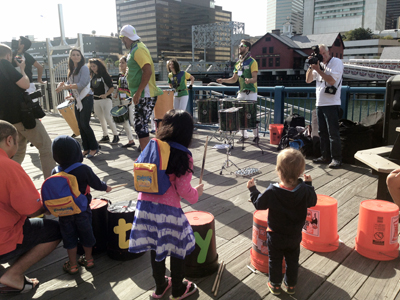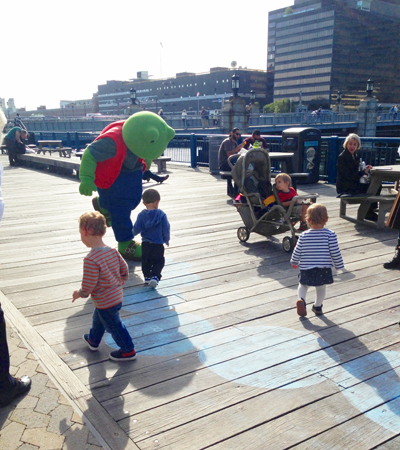The Harvard Family Research Project separated from the Harvard Graduate School of Education to become the Global Family Research Project as of January 1, 2017. It is no longer affiliated with Harvard University.
Supporting Children's Learning Through Play
|
|
 On a terrace, children participate in a drumming circle with Grooversity. |
 Imagination Playground was one of the many guided play stations. |
|
 Children are learning to count at the Sidewalk Math activity with Pablo of Adventures in Curiosityville. |
How can we support children’s learning through play? Leading experts shared their thoughts on the impact playful learning can have on child outcomes at the third Conversation on Early Learning event hosted by Houghton Mifflin Harcourt in partnership with Boston Children’s Museum on September 25, 2015.
Playful learning can happen nearly everywhere. Can a local grocery store or supermarket spark learning? Kathryn Hirsh-Pasek and Roberta Golinkoff, research psychologists and playful learning experts, offer a resounding yes. They are reimagining how we conceive the world around us and see great potential in changing environments into “playful smart zones.” These researchers designed a study in which grocery stores and supermarkets were transformed with engaging and strategic signs in order to encourage conversations between families and their children. For example, in front of the milk section, parents would see a sign saying, “I come from a cow. Can you find something else that comes from a cow?” In low-income neighborhoods, the presence of the signs increased the number of conversations that occurred between children and their parents by 33 percent, equaling the amount of conversation that occurs naturally in middle-income neighborhoods.1
Hirsh-Pasek and Golinkoff are looking into how other community locations, such as bus stops, can also be transformed into learning environments for children and their families. The Ultimate Block Party provides an example of the potential of this work, as it turns city blocks into opportunities for children to engage in hands-on, playful activities. At the Boston Children’s Museum Mini Ultimate Block Party, for instance, children participated in a drumming circle with Grooversity; worked on learning to count by participating in Sidewalk Math; and played Simon Says with Miss Massachusetts 2015, Meagan Fuller.
Children benefit from both child-directed play and guided inquiry. Anna Housley Juster of Boston Children’s Museum wants children to achieve play proficiency by third grade, and emphasizes the importance of helping children achieve balance: They need an opportunity to engage in both play and academic skill building. Children learn best when they are active and engaged, both of which happen when they play. In child-directed play, children select what they want to play; it is both self-directed and self-motivated. Guided inquiry, in contrast, involves adults. It is play that allows children to learn in hands-on ways with adult support and guidance. Hirsh-Pasek and Golinkoff claim that when you have a target learning goal in mind, guided inquiry is a better alternative to child-directed play or to direct instruction for young children. For example, a recent study found that children who engaged in guided play involving new vocabulary words made larger gains in their expressive vocabulary than children in a no-play group.2 Guided play is an effective approach for working with young children.
Children’s museums are places where children learn through play and exploration. Different kinds of play can happen at children’s museums—from pretend play to media play to physical play.3 Pretend play refers to both symbolic play, in which children transform objects into something else, and socio-dramatic play, in which children role play and act out stories. Pretend play promotes creative problem solving, allows children to practice language use, and can improve children’s executive function skills. Media play, in which children use interactive technology, promotes playful learning and offers children the opportunity to practice a variety of skills. The benefits of physical play, in which children engage in physical activity in a playful context, are numerous. Physical play encourages healthy lifestyles and even has the potential to help children perform better academically.
Laura Huerta Migus, executive director of the Association of Children’s Museums, shared that there are more than 300 children’s museums around the world that are reaching more than 30 million children and families. Take advantage of the opportunities provided by a children’s museum by finding one near you.
1 Ridge, K., Weisberg, D., Ilgaz, H., Hirsh‐Pasek, K., & Golinkoff, R. (2015). Supermarket speak: Increasing talk among low‐socioeconomic status families. Mind, Brain, and Education, 9(3), 127-135. doi:10.1111/mbe.12081
2 Weisberg, D., Hirsh‐Pasek, K., & Golinkoff, R. (2013). Guided play: Where curricular goals meet a playful pedagogy. Mind, Brain, and Education, 7(2), 104-112. doi:10.1111/mbe.12015
3 White, R. E. (2012). The power of play: A research summary on play and learning. Retrieved from https://www.mcm.org/uploads/MCMResearchSummary.pdf
SNAPSHOTS CONTRIBUTOR:
As a graduate research assistant at Harvard Family Research Project, Christina Simpson works on projects related to family engagement and program evaluation. Christina is currently a student at Harvard’s Graduate School of Education in the Education Policy and Management program.
SEND US YOUR SNAPSHOTS! If you’re doing something that you think others should know about, we invite you to send us a description with a photo or short video to fine@gse.harvard.edu with the subject line: SNAPSHOTS.
BE INSPIRED BY OTHER SNAPSHOTS!

